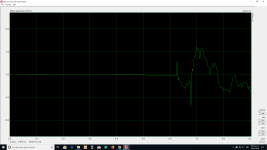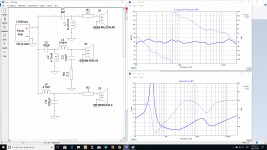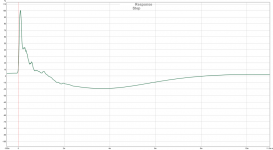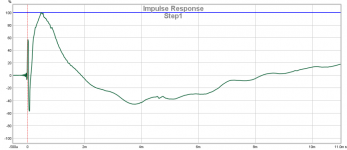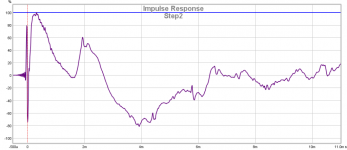Good to see your xover, but that's not tell anything about the individual drivers acoustical roll-off.
If you want to achieve a step response like your target, then you need 1st order Butterworth ACOUSTICAL roll-offs.
1st order acoustical systems usually not worth the effort, or need exceptional drivers, but that's my opinion.
If you want to achieve a step response like your target, then you need 1st order Butterworth ACOUSTICAL roll-offs.
1st order acoustical systems usually not worth the effort, or need exceptional drivers, but that's my opinion.
Last edited:
A 3-way with LR2 acoustic slopes should have step like this Tidal Akira
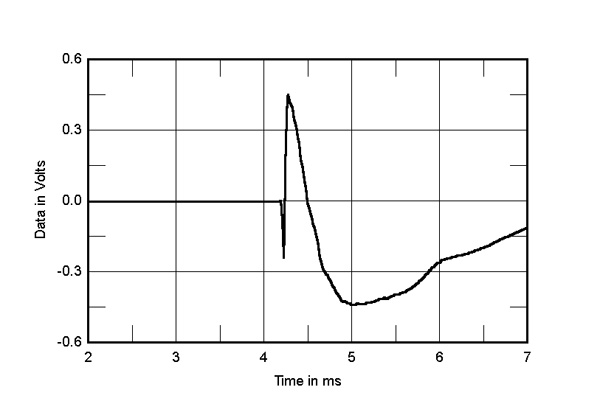
Jim Thiel speakers and Dunlavy's utilize 1st order in multiways, but seeing an ideal one-knee step with a 3-way is rare even with them. This is SC-IV
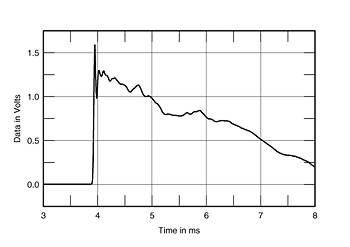
and Thiel CS3.7
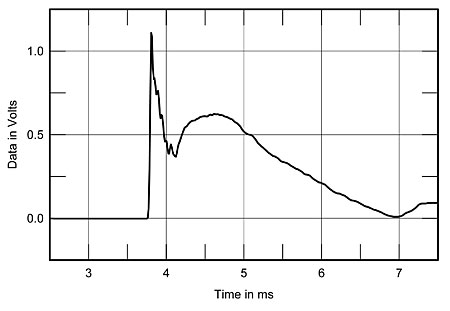

Jim Thiel speakers and Dunlavy's utilize 1st order in multiways, but seeing an ideal one-knee step with a 3-way is rare even with them. This is SC-IV

and Thiel CS3.7

Maybe look at Harsch XO:How to improve step response of a 3 way system.
Target:
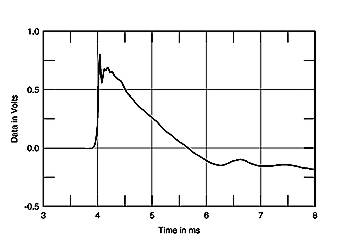
Attached measurement
S. Harsch XO
Good step/impulse response with quite steep slopes. But that requires either delays (DSP) or physical offset.
/Anton
A step response is just another way of looking at frequency magnitude and phase. It requires a relatively flat phase to look decent, or another way of saying the same thing, is it requires as little phase rotation as possible. That's why 1st order crossovers have a nice looking step....they minimize rotation. And also why a 2-way will look better than a 3-way, a 3-way better than a 4, etc...because each crossover will add at least 90 degrees rotation.
Any crossover than minimizes rotation will help step response. Someone mentioned to look at harsch. I'm not familiar with harsch but I know bessel imparts lower rotation than others.
The best looking step and flattest phase we can achieve, comes from using complementary linear phase crossovers. They also allow virtually whatever order you want to use.
I'm not trying to say step is a function of crossover. It is of course the acoustic flat frequency magnitude and phase that makes a good step. I'm just saying we will never get a good looking step response with much crossover phase rotation, no matter how well behaved our drivers are.
The good news about step IMO, is that we can pretty much ignore it. Because there are only two ways to address it: a. work on acoustic phase and magnitude via measurement, which improves any and all measurements b. choose crossovers that rotate less
I say ignore step response, because
We do a. anyway..... in continuous fashion, and b. is a discrete decision that simply defines what kinda step response is achievable (similar to what Juhazi posted for the 3-way LR2) Unless we are using linear phase, first order, or maybe 2nd order crossovers, the theoretically best step response possible with higher orders gets too squirrily looking to try to replicate.
Any crossover than minimizes rotation will help step response. Someone mentioned to look at harsch. I'm not familiar with harsch but I know bessel imparts lower rotation than others.
The best looking step and flattest phase we can achieve, comes from using complementary linear phase crossovers. They also allow virtually whatever order you want to use.
I'm not trying to say step is a function of crossover. It is of course the acoustic flat frequency magnitude and phase that makes a good step. I'm just saying we will never get a good looking step response with much crossover phase rotation, no matter how well behaved our drivers are.
The good news about step IMO, is that we can pretty much ignore it. Because there are only two ways to address it: a. work on acoustic phase and magnitude via measurement, which improves any and all measurements b. choose crossovers that rotate less
I say ignore step response, because
We do a. anyway..... in continuous fashion, and b. is a discrete decision that simply defines what kinda step response is achievable (similar to what Juhazi posted for the 3-way LR2) Unless we are using linear phase, first order, or maybe 2nd order crossovers, the theoretically best step response possible with higher orders gets too squirrily looking to try to replicate.
Last edited:
Beautiful step response can be possible with a linear phase crossover as mark100 said, but there are issues.
1. Sooner or later, you'll find that pre-ringing start annoying you.
2. Digital filter IS flat sounding, especially short FIR.
I was advocating FIR linear phase crossover for a few years, but I was wrong, sorry. If the phase response is not jumpy, it's OK. While it would not be perfect, but better than FIR linear phase, and I was using ultra long impulse, 260,000 steps.
1. Sooner or later, you'll find that pre-ringing start annoying you.
2. Digital filter IS flat sounding, especially short FIR.
I was advocating FIR linear phase crossover for a few years, but I was wrong, sorry. If the phase response is not jumpy, it's OK. While it would not be perfect, but better than FIR linear phase, and I was using ultra long impulse, 260,000 steps.
Very interesting.....
I tried long FIR filters too.....well a longest of 65,000 taps, that is. I'd describe the sound the same way you did....FLAT. I might have heard some pre-ringing, not sure.
At any rate, I can't use PC processing for my applications, so my long tap FIR was just an experiment vs normally using a maximal tap count of 6144 (minidsp openDRCs).
At that tap 6144 count or lower, I hear complete life, nothing flat at all. In fact, transients, clarity, and bass are so rich, it's why I'm a near zealot advocating FIR and linear phase. I have done extensive comparisons against IIR, because I use the gear for live sound, and have to eliminate latency then. There's no question in my mind that FIR rules.
I'm currently using 4096 taps per passband, on a fully integrated processor/amp platform, and on the whole it's easily the best sound I've achieved yet. (A 4-way system)
Did you use global FIR correction, applied to the entire speaker's output? Or driver-by-driver correction, with the correction (IIR hopefully) embedded in the multitude of FIR files, along with linear phase crossovers?
I'm not a fan of global correction at any tap count..... And also not a fan of trying to over correct at the driver-by-driver level....
I tried long FIR filters too.....well a longest of 65,000 taps, that is. I'd describe the sound the same way you did....FLAT. I might have heard some pre-ringing, not sure.
At any rate, I can't use PC processing for my applications, so my long tap FIR was just an experiment vs normally using a maximal tap count of 6144 (minidsp openDRCs).
At that tap 6144 count or lower, I hear complete life, nothing flat at all. In fact, transients, clarity, and bass are so rich, it's why I'm a near zealot advocating FIR and linear phase. I have done extensive comparisons against IIR, because I use the gear for live sound, and have to eliminate latency then. There's no question in my mind that FIR rules.
I'm currently using 4096 taps per passband, on a fully integrated processor/amp platform, and on the whole it's easily the best sound I've achieved yet. (A 4-way system)
Did you use global FIR correction, applied to the entire speaker's output? Or driver-by-driver correction, with the correction (IIR hopefully) embedded in the multitude of FIR files, along with linear phase crossovers?
I'm not a fan of global correction at any tap count..... And also not a fan of trying to over correct at the driver-by-driver level....
Last edited:
Your present step response can actually be read:How to improve step response of a 3 way system?
Attached measurement
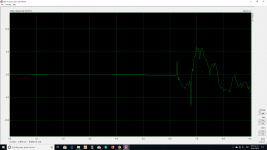
It really helps to have a picture of your loudspeaker in-room under test with all the nearby surfaces and microphone position in order to fully understand what you've got.
But as a stab in the dark, the following are guesses:
That initial spike is your tweeter's response, then the negative going one is the reflection of the tweeter's output off of something that's ~3.4 inches (8.6 cm) greater distance from the direct arrival path. I would guess it's the reflection off the back wall, but it could be other geometries. I would assume that you're using something like a dipole tweeter in order to see such a perfect negative-going spike at that...but I could be wrong.
The next pulse on the step plot is probably your midrange following at 10.9 inches (25.8 cm) of total delay, including the delay from your second order crossover network. The next driver (which we may not be able to see on the step response that you posted because it doesn't show anything farther than 2.75 ms from the initial pulse.
As far as compensating for the crossover network delays, you can move the tweeter back 10.9 inches to get approximate time alignment with the midrange(?). The next driver (woofer?), will likely be behind the midranges, but that distance can't be calculated without having more of the step response duration to look at--to the right of the initial pulse.
[As far as to why you'd want a good step response--a question that you didn't ask, but others imposed the question--I've found empirically that your ears will tell you why it's important. Once you get the transient response of your loudspeakers dialed in, your ears will tell you that something changed--and definitely for the better. It will likely be very subtle to describe, but extremely important to have--once you've heard it. YMMV.]
Chris
This step response is a little enigmatic.
I would expect the negative going peak to be from the midrange. But there are two things that speak against it: 1.) it comes too late because the group delay of the chosen crossover frequency would be around 0.1 to 0.15 ms and the peak is too sharp (i.e. coming from a source with too high an upper cutoff frequency).
But it can definitely not come from a reflection of the tweeter signal because it is inverted - except there is another inverted tweerter somewhere (reflections can only be delayed but never inverted).
And the delay of the woofer response at this low/mid x-over frequency should be around .7 ms. This figure would actually fit the time of the negative pulse. But its shape (too steep) and polarity speak against it.
Question: Are you sure the x-over is wired correctly ?
Regards
Charles
I would expect the negative going peak to be from the midrange. But there are two things that speak against it: 1.) it comes too late because the group delay of the chosen crossover frequency would be around 0.1 to 0.15 ms and the peak is too sharp (i.e. coming from a source with too high an upper cutoff frequency).
But it can definitely not come from a reflection of the tweeter signal because it is inverted - except there is another inverted tweerter somewhere (reflections can only be delayed but never inverted).
And the delay of the woofer response at this low/mid x-over frequency should be around .7 ms. This figure would actually fit the time of the negative pulse. But its shape (too steep) and polarity speak against it.
Question: Are you sure the x-over is wired correctly ?
Regards
Charles
Looking at step response of the speaker, in isolation, is only misleading and does not allow any reasonable evaluation of speaker sound quality. Which one of those is the "best" sounding? What is the difference, in fact, between step_1 and step_2?
Attachments
OP's measured step includes lots of early reflections, but long delay between first and second peak indicates that something is seriously wrong. First peak is typically tweeter and mid should follow it very closely, now there is almost 0,5ms gap. It must sound strange. Listen close to each driver, are they giving the range that they should? You can also measure response in nearfield 1cm from each driver.
We need info about the construction of the speaker and measuring conditions. Crossover might have a mistake too. Someone experienced should see it and take more measurements, at least with midrange inverted.
We need info about the construction of the speaker and measuring conditions. Crossover might have a mistake too. Someone experienced should see it and take more measurements, at least with midrange inverted.
I'd say the first one is from a single, very well-behaved driver in an open baffle or closed box (i.e. a minimum phase bandpass). And if it is from a multiway system it is definitley one with a crossover that doesn't have any phase distortion. Nr. 2 is most probably form an LR4. And Nr 3 could be the same but with lots of room reflections.
Regards
Charles
Edit: I am refering to Pavel's post
Regards
Charles
Edit: I am refering to Pavel's post
Last edited:
Hi Merlin,
would you upload the XSim file (.dxo) here so we can get a closer look at it?
Here we go.
Attachments
- Status
- This old topic is closed. If you want to reopen this topic, contact a moderator using the "Report Post" button.
- Home
- Loudspeakers
- Multi-Way
- How to improve step response
